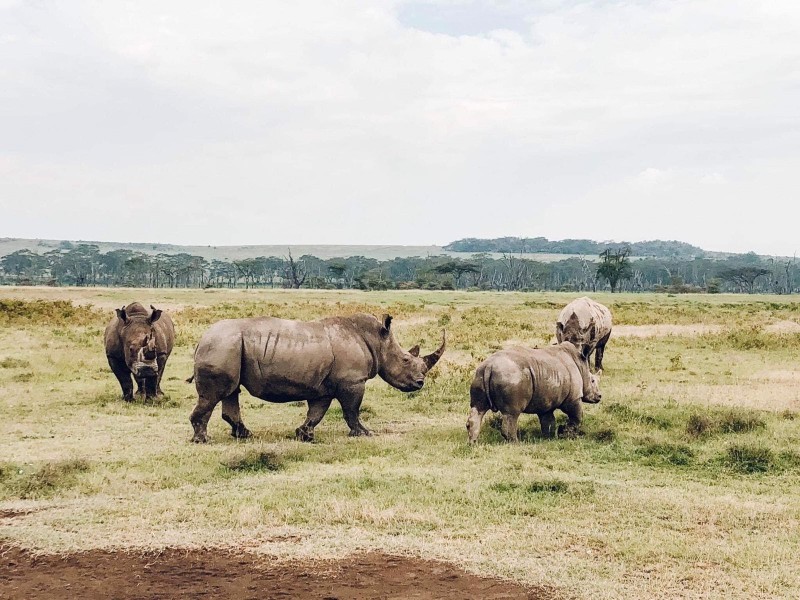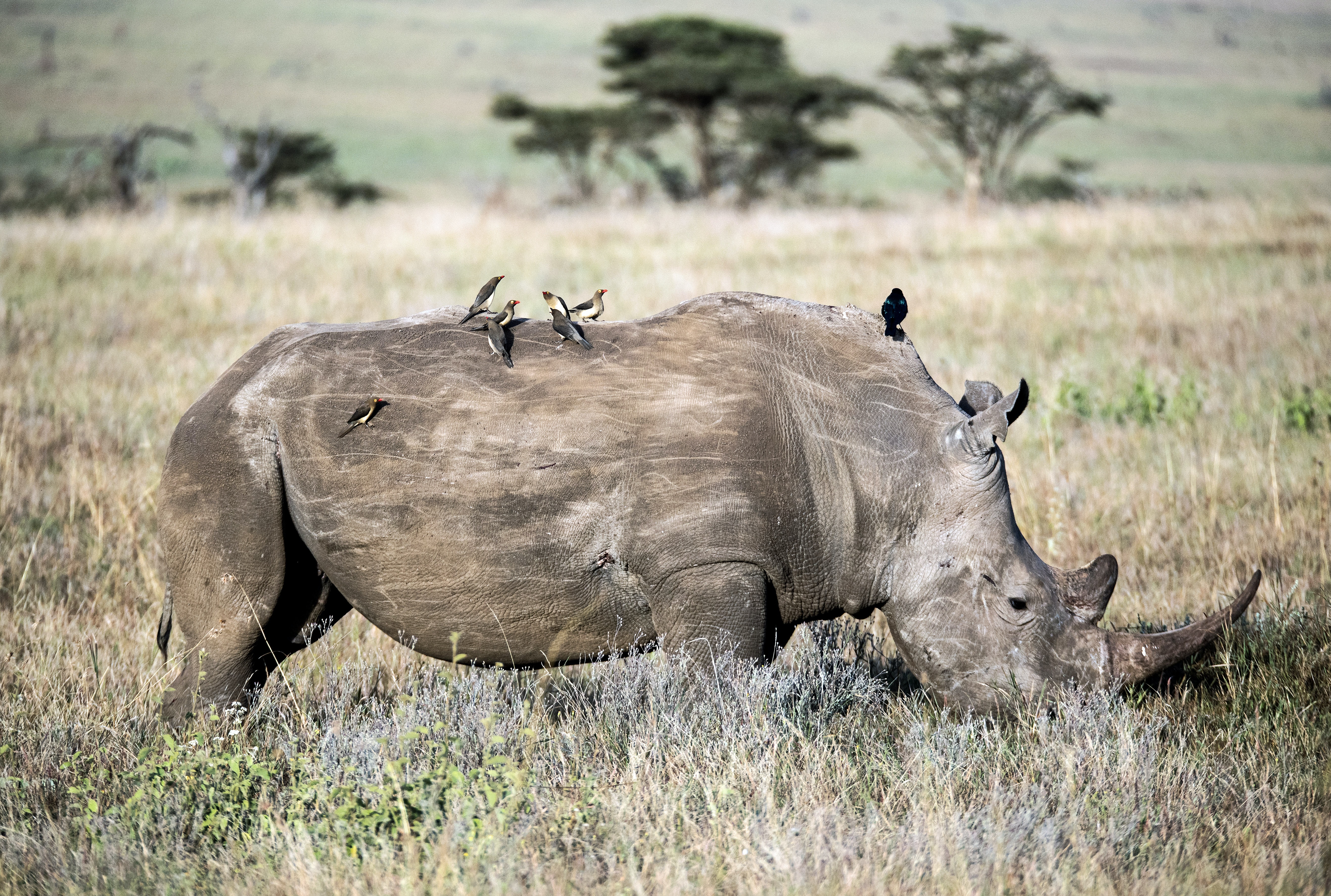Studio
share
By Tori Laniakea.
I will never forget her face.
Those tough, grey layers of flesh spun over the top of knowing eyes. I was certain we were too close. It felt like we were barely a few metres from the mother and her young calf, and we’d heard of coming too close to rhinos, including from our very same audacious safari driver.

Despite it all, I knew how precious and fragile this moment was. Seeing such an exquisite creature in the wild whose species and habitat were so profoundly threatened by humans. And in that joy and that sadness, there was a deep sense of loss wondering whether my own children would ever get to meet this animal, at least in nature.
We all start and end our lives in vulnerability.
As someone who specialises in social policy, I have certainly long grappled with the concept of ‘protection’ of human and non-human life. Rapid biodiversity loss and our climate crisis are deeply and causally intertwined. In the human sphere (totally a thing), a lack of climate action disproportionately burdens the poor because climate change is an amplifier of poverty. Pre-existing differences in our human capital are carried over and reproduced by climate shocks, increasing precariousness along the lines of gender, disability, ethnicity and race, to name a few. Measures being put in place in response to climate change (adaptation) and to slow further change (mitigation) have, in turn, have profound distributional impacts.
Bringing together environmental and social protection is no new concept. We can trace emergent frameworks and language used over recent decades to define this marriage – from corporate responsibility and the SDGs, and our current focus on ESG reporting. Yet, our embedded and unremittingly pursuit of economic growth – where profitability is ‘king’ – has given us a singular focal point, escalating environmental problems, and pushing nature and the climate beyond their limits.
A powerful reframing of our foundations is needed to recognise how the pursuit of planetary and human wellbeing are not only overlapping domains, but are intersectional. And as we hurtle down our current path, we are approaching a state in which we realise that the two are, in fact, one and the same.
We have a choice to align strategies, funding and policies to simultaneously reduce climate threats, alleviate poverty and boost human wellbeing. Within this opportunity, our system of social protection – the welfare state – is challenged to untether from an income poverty lens and “zoom out” on the multi-dimensional systems change espoused by environmental action. Nature-inspired welfare.
Likewise, efforts to address our ecological situation demand a renewed focus on the “parts in the sum”, as envisioned through our welfare state; “zooming in” on the additive effects of people, power and policies working towards re-valuing and re-establishing our connection to nature. Welfare-inspired nature.
In so doing, we may draw upon the power of design to move from human-centred design, to planet-centred design.

Nature-inspired welfare
Welfare states represent the hand of government and their role in protecting the economic and social wellbeing of its citizens.
Welfare states, such as the one we have in Australia, typically centre on creating access to a basic income for the “deserving poor”: those meeting eligible conditions of vulnerability. Criticisms of our welfare state highlight how our growth-oriented model overlooks how socio-political structures reproduce power relations and inequalities that are intrinsic conditions contributing to vulnerability to climate change.
In its simplest form, the goal is protection. The “bottom rung”.
Yet, we can find a spectrum of policy choices set within the social protection bedrock, demonstrating how a transformative capacity takes a systems-level view of addressing the complexity of the climate crisis (see Figure 1).

Figure 1: Social protection functions and their contribution to climate adaption. Derived from Béné et al. 2012
Transformation becomes about building household resilience before shocks occur, and improving systemic responses of social protection when they do.
Beneath this umbrella, I suggest three pivotal policy actions to achieve nature-inspired welfare:
- Expanding our conceptualisation of vulnerability. Effective policy to reduce poverty requires multi-dimensional thinking across financial, human, physical, natural and social capital layers. The scalability of social protection needs to be expanded both vertically (increasing service coverage and support above relative poverty lines) and horizontally (including non-regular beneficiaries to account for new and emerging climate-related vulnerabilities). This movement towards assessing poverty as a dynamic phenomenon makes visible the fact that people may move above and below “poverty lines” in response to various climate and non-climatic shocks and stresses. Adopting social lifecycle assessment approaches and outcomes-based contracting (e.g. social impact bonds) across the design, delivery and evaluation of social protection can strengthen system responsiveness.
- Improving information and data systems underpinning climate-responsive social protection. The effectiveness of program delivery after a climate shock depends on available data capabilities to classify potential beneficiaries and to define and plan for responsive actions. Adapting current information systems, technology and infrastructure underpinning critical service systems (e.g. welfare payment system, healthcare, supply chains) should be performed with an emphasis on digitalisation, data interoperability and future-proofing. Investing in contingency delivery systems and repositioning risk financing can ensure timely distribution after a climate event occurs. Forecasted and “ear-marked” funding could support early warning measures through planned anticipatory actions (e.g. relying on pre-defined triggers).
- Addressing the distributional impacts of extreme climate events. There are regions at high-risk of social and economic collapse through either the effects of the destruction of nature, rising temperatures and extreme climate events, or responses to climate change (e.g. declining demand for coal and effect on towns centred on mining). A continuum of protective instruments is needed to support these transitions, from short-term safety nets to longer-term adaption strategies (e.g. re-skilling, sustainable cities, economic migration, etc.). Integration of climate solutions should include human wellbeing indicators and co-benefits (see Figure 2).

Figure 2: Integration of climate solutions with human development co-benefits. Source: Jameel et al. 2022.
Welfare-inspired nature
The construction of the welfare state provides important lessons to the emerging ‘environmental state’.
Welfare states are reproduced in a continuing process where countries define their beneficiaries, build capacities and taxation policies, and develop a construct for conditionality and eligibility, all stemming from the consolidation of shared ideas, interests and institutions. For most modern welfare states, however, its enduring relevance is grounded in a value-laden agreement that poverty is an “unacceptable state of the human condition” that we should seek to reverse.
Climate change is the most important human development challenge of our time. It intensifies the effects of poverty and environmental degradation and disrupts economies. Climate mitigation and socioeconomic development can, and must be, simultaneously produced.
From our lessons in designing a welfare state, we can draw benefits from investing in three policy spaces:
- Redesigning incentives through regulation and by assigning rights to nature. When we shift from ‘rights to nature’ to ‘rights for nature’, we can steel-push a systemic shift that creates a social safety net and assigns a voice to agents of nature. Leading social policy instruments – such as taxation and regulation – become powerful tools in redirecting human behaviour towards creating a circular path. This can align incentives that layer the foundations of a carbon industry, transition energy developments, and accelerate clean exports, to name a few priorities.
- Supporting nature to adapt to a changing climate. As social policies and beneficiaries change in response to a varying social climate, phenomenally, we are seeing nature evolve in response to our human footprint. In some cases, animals are shapeshifting in response to rising temperatures, corals are adapting their phenotypic plasticity, whilst other species are changing their migration patterns. Despite these adaptions, the rate of species and habitat loss is unprecedented, and nature is losing the war. Human intervention may involve increasing connectivity between environments through science, technology and knowledge systems to support a diversity of polyculture and agroforestry systems, as well as creating and improving markets (e.g. pricing of negative externalities) to integrate nature and communities as new beneficiaries of the climate economy.
- Mainstreaming climate-first policies and nature-positive action into public service decision-making. We know that social and environmental protections are most effective when integrated into non-climatic policies, capabilities and governance mechanisms. Simultaneously addressing assets, capacities and the risk of shocks will have lasting changes for vulnerable livelihoods. While every region is likely to have differing priorities, emphasis should be placed on critical systems linking biodiversity and nature’s contributions to people (e.g. food, energy, transport, manufacturing, etc.). Transformation of these sectors should be based on building resilience through policies targeting climate-proofing systems.

Final thoughts
Nothing gives me a stronger sense of centre than tapping into our shared connection to nature. In fact, I could probably live in the forest, if I wasn’t so addicted to barista coffee. And my dog isn’t allowed in national parks.
In the past, forests acted in many roles and functions as part of greater ecosystems and as a multiplier of life. Yet, the move towards the timber industry caused a redefining of how we saw forests, and a redesigning of their physical structure. Reducing forests to a single purpose, humans cut them down to make space to replant lines of a particular species of fast-growing trees to maximise the financial production potential of the timber industry.
The resulting degradation of biodiversity, the relationships between plants, animals and people, and the vast and unknowable networks within these forests revealed itself through ecosystem collapse. The very destruction of these relationships led to the distortion of the very things on which the timber trees depended (e.g. soil nutrients, natural pest prevention), effectively ending economic gains.
We rejected the complexity of our interdependencies, and in doing so, diminished ourselves.
The intersectionality of our welfare and nature is like an orchestra; complex, harmonious and interdependent. More than 1 billion people experiencing extreme poverty depend on forests to meet their basic needs for housing, water, and fuel, as well as their primary source of income. By way of example, the World Bank estimates that improving agriculture and agroforestry would be 11 times more effective at reducing extreme poverty in sub-Saharan Africa than investments in any other sectors.
Planetary wellbeing should not be seen not as an abstract concept, but rather as a living, dynamic expression of our own human development.
As these two domains move closer together towards an equilibrium state that is environmentally safe and socially just, we have an opportunity to combine the old and the new. An opportunity to design resilient ecosystems and communities through a transformative social protection framework and centred on reforging our links with our planet.
How we align these fields will be pivotal to understanding not only how each can contribute to solving for the other, but more profoundly, how they are the same.